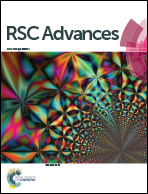Assessment of cathode materials for Ni(ii) reduction in microbial electrolysis cells
Abstract
The microbial electrolysis cell (MEC) is emerging as a new technology for the removal and recovery of nickel from electroplating effluents, which removes organic matter and nickel ions simultaneously. Cathode materials play an important role in MEC for nickel recovery. The commonly used cathode materials, stainless steel mesh (SSM), copper sheet (CS), graphite plate (GP) and carbon cloth (CC) were compared and evaluated in terms of the electrochemical performance of the MEC, nickel removal ratio and energy consumption. CV curves were used to determine the applied voltage. The results showed that the stable current on the CC cathode was 0.82 mA, which was higher than the SSM cathode (0.58 mA), CS cathode (0.71 mA) and GP cathode (0.75 mA). The nickel removal ratio and cathode efficiencies indicated that the cathode electrode was the limiting factor for nickel ion reduction in the present conditions. While the CS cathode showed the best performance, which gained the highest cathode efficiency (148.56 ± 2.03%), nickel removal ratio (40.7 ± 0.55%) and the lowest energy consumption (0.61 ± 0.01 kW h kg−1 Ni). The present technology with metallic nickel deposition on CC provides a practical and economical method for nickel ions recovery.


 Please wait while we load your content...
Please wait while we load your content...